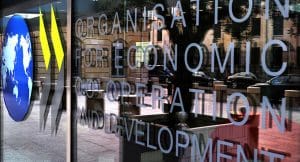
All Content

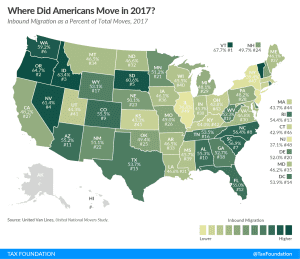
Where Did Americans Move in 2017?
There are many ways that states can compete with one another for residents, and tax rates and structures should certainly be part of the conversation for states looking to attract new residents.
2 min read
Mississippi Lawmakers Consider Creation of State Lottery
As Mississippi policymakers contemplate a lottery, it may be tempting to think of it as free money—new revenue raised without having to adopt a new tax. A better way of thinking about the issue, however, would recognize the lottery for what it is: a regressive form of high implicit taxation.
3 min read
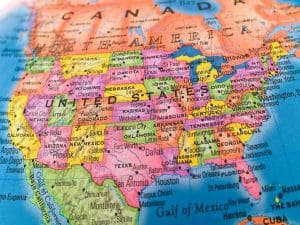
State Strategies to Preserve SALT Deductions for High-Income Taxpayers: Will They Work?
The scramble to restore the full state and local tax deduction for high-income taxpayers has resulted in inventive proposals that, for both legal and practical reasons, are unlikely to succeed.
22 min read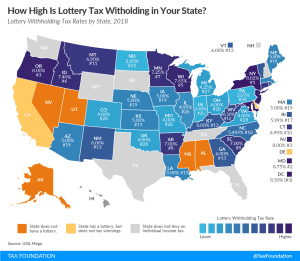
What Percentage of Lottery Winnings Would be Withheld in Your State?
You probably aren’t going to win the Powerball jackpot, but your state already has. Here’s a look at lottery withholding tax rates by state.
2 min read
Other Federal Tax Changes in the New Year
Though the focus has been on the Tax Cuts and Jobs Act, there are other federal changes that took place on January 1, 2018 which are also worth reviewing.
3 min read
Retirement Savings Left Largely Untouched by Tax Reform
While rumors flew around Washington in the fall that the Tax Cuts and Jobs Act would dramatically impact retirement savings accounts, the plan has made only a few minor modifications.
3 min read
2018 Tax Brackets
With the passage of the Tax Cuts and Jobs Act (TCJA), many tax brackets, thresholds, and rates will change in 2018. Explore 2018 tax brackets, standard and personal exemptions, earned income tax credit, and more.
4 min read



Trade and Capital Flow Consequences of Tax Reform: A Means to a Faster Expansion of U.S. Capital Formation and Employment
The tax bill will boost investment and incomes in the United States, and make the country a better place to locate production and hiring. There will be a transitory rise in the trade deficit, but in the context of a stronger, faster-growing economy.
5 min read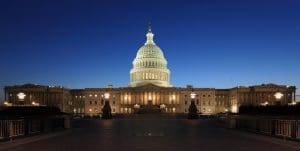
Statement on Final Passage of the Tax Cuts and Jobs Act
With the Tax Cuts and Jobs Act, Congress took a historic step toward rewriting the U.S. tax code for the first time since 1986.
1 min read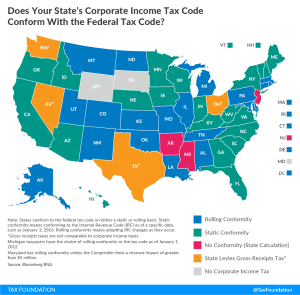
Does Your State’s Corporate Income Tax Code Conform with the Federal Tax Code?
Whether your state’s corporate income tax code conforms to the federal corporate income tax code matters a great deal for how the Tax Cuts and Jobs Act will impact revenue in your state.
2 min read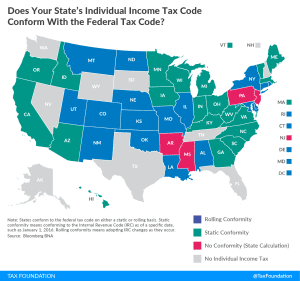
Pass-Through Deduction Won’t Flow Through to Most States
For policymakers in most states, the fact that the pass-through deduction doesn’t affect AGI should come as a relief. For those in the six states which use federal taxable income as their starting point for conformity, decoupling from the provision is an entirely viable option.
2 min read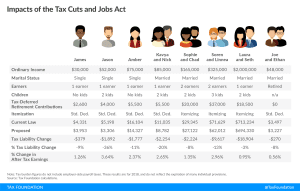
Who Gets a Tax Cut Under the Tax Cuts and Jobs Act?
How would the Tax Cuts and Jobs Act impact different households? Check out our sample taxpayers to see what would change if the bill is enacted.
5 min read
The Tax Cuts and Jobs Act: The Impacts of Jobs and Incomes by State
Overall, the Tax Cuts and Jobs Act is projected to add 339,000 new jobs to the U.S. economy and boost average after-tax incomes for middle-income families by $649.43. Here’s how jobs and after-tax wages will be impacted in your state.
2 min read
Preliminary Details and Analysis of the Tax Cuts and Jobs Act
According to the Tax Foundation’s Taxes and Growth Model, the Tax Cuts and Jobs Act would lead to a 1.7 percent increase in GDP over the long term, 1.5 percent higher wages, an additional 339,000 full-time equivalent jobs, and cost $1.47 trillion on a static basis and by $448 billion on a dynamic basis.
22 min read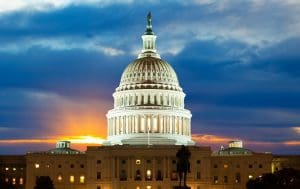
The Tax Cuts and Jobs Act: Preliminary Economic Analysis
According to the Tax Foundation’s Taxes and Growth Model, the Tax Cuts and Jobs Act would lead to a 1.7 percent increase in GDP over the long term, 1.5 percent higher wages, an additional 339,000 full-time equivalent jobs, and cost $1.47 trillion on a static basis and by $448 billion on a dynamic basis.
2 min read